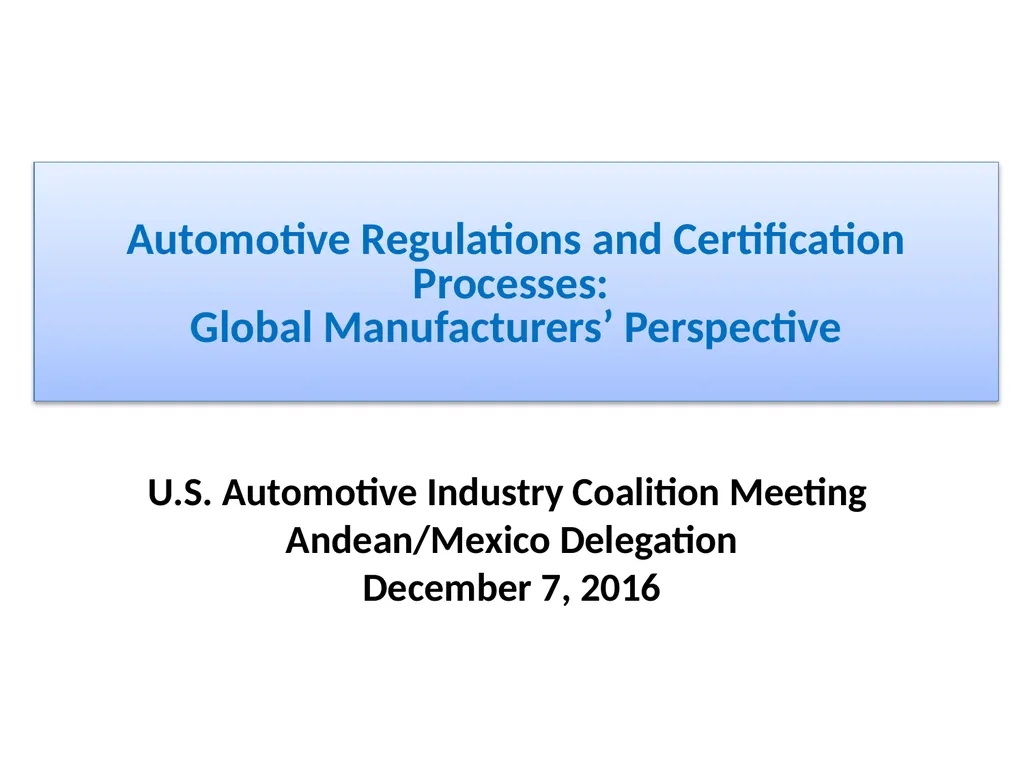Automotive Regulations and Certification
Author : tatyana-admore | Published Date : 2025-11-08
Description: Automotive Regulations and Certification Processes Global Manufacturers Perspective US Automotive Industry Coalition Meeting AndeanMexico Delegation December 7 2016 World Without Regulatory Borders 2 The ideal is to test once and sell
Presentation Embed Code
Download Presentation
Download
Presentation The PPT/PDF document
"Automotive Regulations and Certification" is the property of its rightful owner.
Permission is granted to download and print the materials on this website for personal, non-commercial use only,
and to display it on your personal computer provided you do not modify the materials and that you retain all
copyright notices contained in the materials. By downloading content from our website, you accept the terms of
this agreement.
Transcript:Automotive Regulations and Certification:
Automotive Regulations and Certification Processes: Global Manufacturers’ Perspective U.S. Automotive Industry Coalition Meeting Andean/Mexico Delegation December 7, 2016 World Without Regulatory Borders 2 The ideal is to test once and sell anywhere, maintaining high levels of safety and environmental protection. Global automakers build and sell in markets across the world, promoting trade and investment We live in an increasingly interrelated and integrated world Automobile Safety & Environmental Impact Governments everywhere are looking for ways to make their roads safer and reduce the impact on the environment associated with motor vehicles Despite significant improvements- According to the United Nation’s World Health Organization, Road traffic injuries are the ninth leading cause of death globally, and the principal cause of death among those aged 15–29 years. 3 Safety Concept Allocation of Responsibility INFRASTRUCTURE Quality / Capacity Repair / Grow DRIVER Training / License Age / Fitness / Renewal OPERATION Limitations / Environment Conditions / Rules VEHICLE Features / Attributes Inspect / Maintain / Modify ~90% FAULT SMALL % 4 How to Address Societal Challenges US Federal Motor Vehicle Safety Standards (FMVSS) and Environmental Protection Agency (EPA) rules and, UN Economic Commission for Europe (ECE) standards, now referred to as UN regulations under the 1958 Agreement There are two major - equally robust sets of existing motor vehicle safety and environmental regulations 5 Moving toward Global Technical Regulations (GTRs) In 1998 the UN started to administer a new agreement specifically to develop harmonized Global Technical Requirements (GTRs) for motor vehicles and motor vehicle equipment. UN GTRs provide a predictable regulatory framework for the global automotive industry, consumers and their associations. They do not contain administrative provisions for type approvals and their mutual recognition. The 1998 Agreement has 34 contracting parties (19 if the EU and members are counted as one- in 2015). Both the U.S. and EU, as a single block, (one vote) are contracting parties to the ‘98 Agreement. There are currently 16 GTRs that have been developed under the ‘98 Agreement: Twelve light duty standards/regulations, Three motorcycle standards One off-road emissions standard Under the ‘98 Agreement there are currently no certification or CoP provisions. Those are left up to each contracting party. 6 Why Accept U.S. & ECE/EU Certified Vehicles? While work continues to develop more GTRs, and flaws in the GTR development process are fixed, it is strongly recommended that economies maintain regulatory policy that accepts vehicles for sale in the













